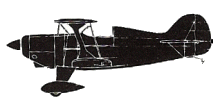
ASN Wikibase Occurrence # 138044
This information is added by users of ASN. Neither ASN nor the Flight Safety Foundation are responsible for the completeness or correctness of this information.
If you feel this information is incomplete or incorrect, you can submit corrected information.
| Date: | Saturday 20 August 2011 |
| Time: | 13:41 |
| Type: |  Vertical Unlimited 12 (modified Pitts 12) |
| Owner/operator: | Vertical Unlimited LLC |
| Registration: | N2BJ |
| MSN: | 297 |
| Year of manufacture: | 2009 |
| Total airframe hrs: | 207 hours |
| Engine model: | Vendenyev M14P |
| Fatalities: | Fatalities: 1 / Occupants: 1 |
| Aircraft damage: | Substantial |
| Category: | Accident |
| Location: | Charles B. Wheeler Downtown Airport - KMKC, MO -
 United States of America United States of America
|
| Phase: | Manoeuvring (airshow, firefighting, ag.ops.) |
| Nature: | Demo/Airshow/Display |
| Departure airport: | Kansas City, MO (MKC) |
| Kansas City, MO (MKC) | |
| Investigating agency: | NTSB |
| Confidence Rating: |
The accident occurred during an air show performance. Video footage and photographs of the final portion of the accident routine revealed that the airplane exited a Lomcevak maneuver into a right-hand, inverted spin. The pilot recovered from the inverted spin, but the airplane immediately entered a left upright spin. (Most of the time, a recovery from the Lomcevak maneuver would be straight ahead, but occasionally recovery from an inverted spin would be necessary.) The airplane appeared to yaw left during the final descent, completing about 1 1/2 revolutions before impacting the ground and then coming to rest upright. The photographs indicated that the airplane was intact; however, the elevators were deflected upward, which was inconsistent with a spin recovery. The pilot's friend reported that the pilot appeared to initiate the Lomcevak maneuver more aggressively than he had seen during previous airshow performances. Another friend, who had trained with the pilot and was familiar with the routine, reported that the Lomcevak maneuver completed during the accident flight included an extra rotation. All major airframe components were observed in place relative to the overall airframe. A postaccident examination of the airplane and a teardown examination of the engine did not reveal any anomalies consistent with a preimpact failure or malfunction. No evidence of an in-flight structural failure was observed.
Toxicology testing indicated the distant use of Valium by the pilot; however, it is not likely to have been directly impairing at the time of the accident. A review of the pilot's medical records indicated that he had sought treatment for vertigo after feeling off-balance and nauseated while conducting aerobatics; additionally, the pilot reported that he had fallen after getting out of the airplane. An initial medical evaluation was conducted, and further treatment was prescribed; however, the records indicated that the pilot did not return for treatment. In addition, autopsy results revealed that the pilot suffered from severe coronary artery disease and had an enlarged heart and a congenital valve anomaly. Histology of the right and left ventricle walls was consistent with myocardial ischemia. These conditions placed the pilot at an increased risk of an acute coronary event, including a cardiac arrhythmia and sudden cardiac death, although insufficient evidence exists to determine whether the pilot experienced an acute cardiac event at the time of the accident. The extent that vertigo might have caused the accident could not be determined; however, the persistence of the vertigo symptoms after completion of aerobatic maneuvers suggested that it might have played a role in the pilot's loss of control.
Probable Cause: The pilot's impairment during an aerobatic airshow performance for reasons that could not be determined based on available information, which resulted in an in-flight loss of airplane control.
Accident investigation:
 |
|
Sources:
NTSB
Location
Revision history:
| Date/time | Contributor | Updates |
|---|---|---|
| 20-Aug-2011 18:12 | RobertMB | Added |
| 21-Dec-2016 19:26 | ASN Update Bot | Updated [Time, Damage, Category, Investigating agency] |
| 27-Nov-2017 17:04 | ASN Update Bot | Updated [Operator, Other fatalities, Departure airport, Destination airport, Source, Narrative] |
Corrections or additions? ... Edit this accident description
The Aviation Safety Network is an exclusive service provided by:


 ©2024 Flight Safety Foundation
©2024 Flight Safety Foundation